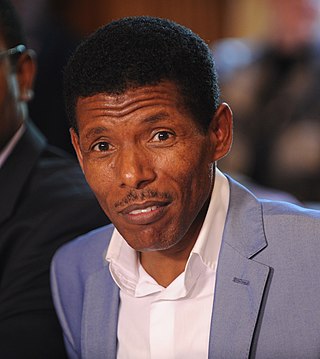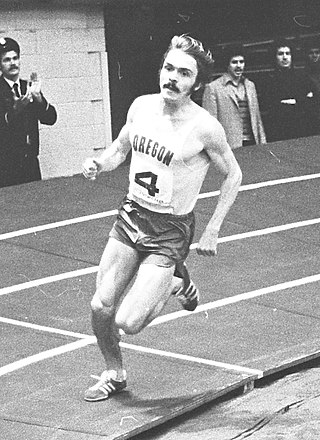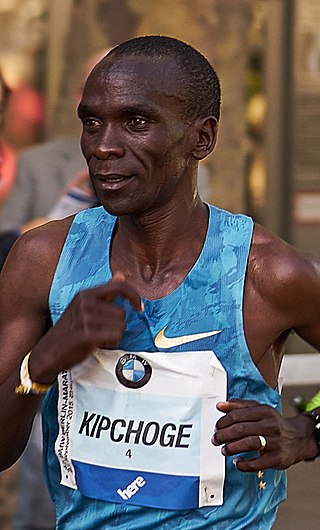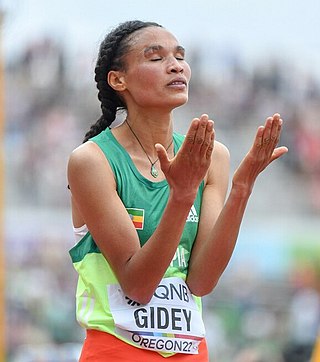
Haile Gebrselassie is an Ethiopian former long-distance track, road running athlete, and businessman. He won two Olympic gold medals and four World Championship titles over the 10,000 metres. Haile triumphed in the Berlin Marathon four times consecutively and also had three straight wins at the Dubai Marathon. Further to this, he earned four world titles indoors and was the 2001 World Half Marathon Champion.

Steve Roland "Pre" Prefontaine was an American long-distance runner who from 1973 to 1975 set American records at every distance from 2,000 to 10,000 meters. He competed in the 1972 Summer Olympics, and was preparing for the 1976 Olympics with the Oregon Track Club at the time of his death in 1975. Prefontaine's career, alongside those of Jim Ryun, Frank Shorter, and Bill Rodgers, generated considerable media coverage, which helped inspire the 1970s "running boom." He died at age 24 in an automobile crash near his residence in Eugene, Oregon. One of the premier track meets in the world, the Prefontaine Classic, is held annually in Eugene in his honor. Prefontaine's celebrity and charisma later resulted in two 1990s feature films about his short life.

David James Wottle is an American retired middle-distance track athlete. He was the gold medalist in the 800 meter run at the 1972 Summer Olympics in Munich and a world record holder in the 800 meters. In 1973, Wottle also ran the 3rd fastest Mile in history. He was known for wearing a golf cap while running.

A pacemaker or pacesetter, sometimes informally called a rabbit, is a runner who leads a middle- or long-distance running event for the first section to ensure a high speed and to avoid excessive tactical racing. Pacemakers are frequently employed by race organisers for world record attempts with specific instructions for lap times. Some athletes have essentially become professional pacemakers. A competitor who chooses the tactic of leading in order to win is called a front-runner rather than a pacemaker.

Eliud Kipchoge is a Kenyan long-distance runner who competes in the marathon and formerly specialized at the 5000 metre distance. Regarded as one of the greatest marathon runners of all time, he is the 2016 and 2020 Olympic marathon champion, and was the world record holder in the marathon with a time of 2:01:09 set at the 2022 Berlin Marathon, until being broken by Kelvin Kiptum at the Chicago Marathon on 8 October 2023 with a time of 2:00:35. He has run four of the seven fastest marathons in history.

Galen Rupp is an American long-distance runner. He competed in the Summer Olympics in 2008 in Beijing, 2012 in London, 2016 in Rio de Janeiro and 2021 in Tokyo. He won the silver medal in the men's 10,000 meters in London and the bronze medal in the men's marathon in Rio de Janeiro. Rupp competed for the University of Oregon and trained under Alberto Salazar as a member of the Nike Oregon Project. He won the 2017 Chicago Marathon, becoming the first American to do so since Khalid Khannouchi in 2002. Rupp won the marathon at the 2020 U.S. Olympic Trials in Atlanta with a time of 2:09:20, and qualified for the 2020 Tokyo Olympic Games, where he finished eighth.

Shalane Grace Flanagan is an American long-distance runner, Olympic medalist and New York City Marathon champion. She was the first American woman to win the New York City Marathon since 1977. She holds the NACAC area records in both the 10k and 15k road races.

Wilson Kipsang Kiprotich is a Kenyan professional athlete who specialises in long-distance running, competing in events ranging from 10 km to the marathon. He was the bronze medallist in the marathon at the 2012 Summer Olympics. He is the former world record holder in the marathon with a time of 2:03:23, which he set at the 2013 Berlin Marathon. He has run under 2 hours 4 minutes for the marathon on four occasions.

Matthew Centrowitz Jr. is an American middle-distance runner who is the 2016 Olympic champion in the 1500 meters.

The 2011 Chicago Marathon was the 34th edition of the annual marathon race in Chicago, Illinois which was held on Sunday, October 9. The men's race was won by Kenya's Moses Mosop in a time of 2:05:38 hours – a course record. Ejegayehu Dibaba, making her marathon distance debut, was the women's winner in 2:22:09. Some 37,400 runners started the event and the final total of 35,670 finishers was the second highest in its history.

Geoffrey Kipsang Kamworor is a Kenyan professional long-distance runner. He won the silver medal in the 10,000 metres at the 2015 World Championships in Athletics. Kamworor claimed victories at the World Half Marathon Championships three times in a row from 2014 to 2018. He took individual titles at the World Cross Country Championships in 2015 and 2017, and finished third in 2019. He won his first World Marathon Major at the 2017 New York City Marathon and regained his title in 2019, after a second-place finish in 2015. Kamworor also placed second at the 2023 London Marathon and earned three other podium finishes at a World Marathon Majors.

The 2014 London Marathon was the 34th running of the annual marathon race in London, England, which took place on Sunday, 13 April. The men's elite race was won by Kenyan Wilson Kipsang Kiprotich and the women's race was won by Kenyan Edna Kiplagat. The men's wheelchair race was won by Switzerland's Marcel Hug and the women's wheelchair race was won by American Tatyana McFadden. Kipsang and McFadden set course records.

The men's 10,000 metres event at the 2016 Summer Olympics took place on 13 August at the Olympic Stadium. In a tactical yet comparatively quick race, Great Britain's Mo Farah defended his Olympic title in 27:05.17 minutes, becoming the sixth man to win the Olympic 10,000 metres title twice. Reaching their first Olympic podium, Kenya's Paul Tanui was the silver medallist and Tamirat Tola of Ethiopia took the bronze.
Pacing strategies in track and field are the varied strategies which runners use to distribute their energy throughout a race. Optimal strategies exist and have been studied for the different events of track and field. These optimal strategies differ for runners in sprint events, such as the 100 meters, runners in middle-distance events, such as the 800 meters or the mile run, and runners in long-distance events, such as the 5000m or marathon. Additionally, pacing typically differs between different styles of races. For instance, in a time trial, where the goal of a racer is simply to run the fastest time, participants will typically employ the aforementioned optimal pacing strategy. However, in a championship race, where the goal of the racer is to win, the pace is typically slow in the beginning of the race and gradually speeds up for a sprint finish, often meaning the race is run with a negative split. Typically, to run a world record, the runner must employ a near-optimal pacing strategy.

The 2015 London Marathon was the 35th running of the annual marathon race in London, England, which took place on Sunday, 26 April. The men's elite race was won by Kenyan Eliud Kipchoge and the women's race was won by Ethiopian Tigist Tufa. The 2015 IPC Athletics World Championships marathon events were also held during the race. The men's wheelchair race was won by Josh George from the United States and the women's wheelchair race was won by American Tatyana McFadden. McFadden set a course record for the second year running.

Letesenbet Gidey is an Ethiopian long-distance runner who holds two world records and one world best. In the 10,000 metres, she is the 2020 Tokyo Olympic bronze medallist, 2019 World silver medallist, and 2022 World champion.
A kick in a running race is the ability of some athletes to sprint at the end of an endurance-oriented race. For those who possess the ability to kick, it is a strategic weapon. For those with the liability not to possess a kick, they must seek different strategies to anticipate and diminish their opponent's kicking power, usually by a long extended surge to break away or exhaust their opponent well ahead of the finish of the race. Similar to a sprinter in cycling, a kicker has a finite distance they know they are able to sprint, making their strategy to be in the ideal position at that distance to be able to utilize that speed. Sprinting too early could lead an athlete to tie up, a form of muscle cramp that debilitates a racer from continuing to kick. Thus team tactics might also intentionally or not, box a kicker, meaning to position other competitors to their outside, to disrupt their positioning and timing. Of course, as the finish is nearing and all athletes are straining, this becomes more difficult to accomplish deliberately.

The Ineos 1:59 Challenge, held on 12 October 2019, was an attempt by Kenyan athlete Eliud Kipchoge to break the two-hour mark for running the marathon distance, which he achieved in a time of 1:59:40.2. The event was specifically created for Kipchoge and held in Vienna, Austria. Kipchoge had previously attempted to run a two hour marathon at the Breaking2 event organised by Nike in 2017, but he fell short by 25 seconds. He then went on to run a world record marathon at the 2018 Berlin Marathon before British chemicals company Ineos announced the attempt in May 2019. 41 pacemakers, rotating in and out in groups of 7, assisted Kipchoge throughout the attempt.
The 2019 Chicago Marathon was the 42nd annual running of the Chicago Marathon held in Chicago, Illinois, United States on October 13, 2019. The men's race was won by Kenyan Lawrence Cherono in 2:05:45 while the women's was won by Kenyan Brigid Kosgei in 2:14:04, a world record by 81 seconds. The men's and women's wheelchair races were won by Daniel Romanchuk and Manuela Schär in 1:30:26 and 1:41:08, respectively. More than 45,000 runners completed the race.

The 2022 Berlin Marathon was the 48th edition of the annual marathon race in Berlin, which took place on Sunday, 25 September 2022. An Elite Platinum Label marathon, it was the first of four World Marathon Majors events to be held over the span of six weeks. 45,527 runners with 34,879 finishers from 157 countries have taken part in the event.



















